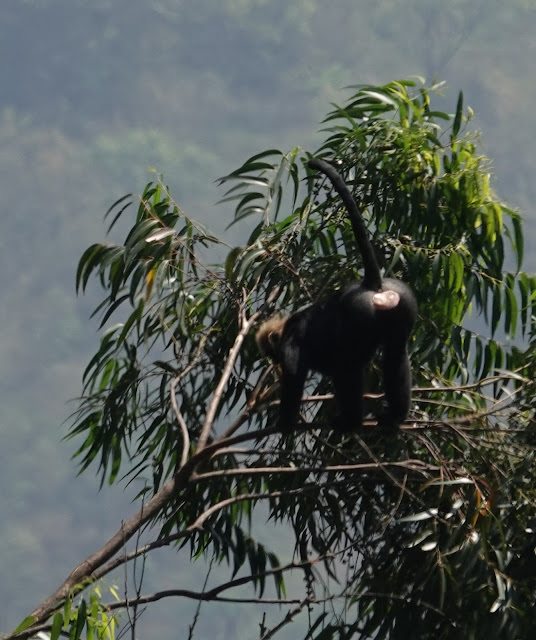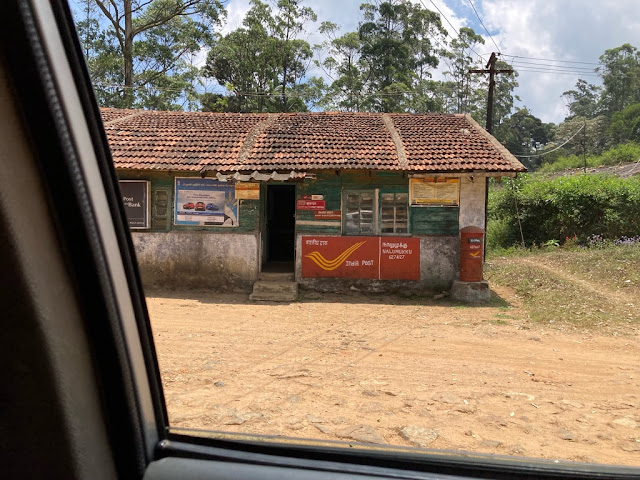Day 2: 18 April 2023
By Gayathri R
(My comments in italics)
After a good night’s sleep, we started our day early at 5:15 AM.
 |
| This Then Vazhapazham bunch - rapidly vanished across the days we were there, and I plead guilty to eating many of them. |
 |
| Leaving the campus. |
We had Mr. Thanikaivel and Mr. Isakki to guide us along. We were split into groups in 5 cars and set off to Maanjolai, which is around 1162 metres above sea level.
 |
| Manimuthar waterfalls - a beautiful view in the start while climbing the hill. |
 |
| With the goal of finding the Varai Aadu or the Nilgiri Tahr, we stopped at a place where we could see steep cliff faces. Few were lucky enough to spot some movement of the Tahr. |
 |
| It seems this region has more than 50 endemic species. We were able to spot Red Spurfowl, Painted Spurfowl and Grey Junglefowl on the roads. Also we noticed Lemongrass planted along the roadside. |
 |
| There were beautiful trees and a Bellerica as well. |
 |
| To be identified |
Maanjolai is a small peaceful village with rolling tea plantations which was a sight to behold. We had tea and rusk in a local shop.
Here we spent some time birding in the nearby tea farm.
We also stopped to see the enigmatic Nilgiri Langurs on a far away tree. Few of us were lucky enough to spot them right out of our car windows on the way back.
 |
| Photo by Sagarika - She saw the langurs from the car, I think? I saw them far away in the canopy but well seen through the binoculars. This one was obviously disgusted with us... |
There was a lot of time and gesticulating needed before we all saw it, so well camouflaged was it, until it openened the patagium - probably there was a female around. Many in the group were seeing these agamid lizards for the first time, and we were all awestruck at the spotting by Thanikavel, given how well camouflaged it was - he spotted it from the moving vehicle! I was even more amazed at those who got photographs of it.
Kakachi
 |
| Our next stop was a place named Kakachi which was a golf ground during the British time. The grassland was surrounded by Eucalyptus trees. |
 | ||
| There was a waterbody which hosted a variety of butterflies and odonates. |
 |
| More of it, on our return. |
 |
| A fabulous tree - from the car - what was it? We sighted the Crested-serpent Eagle soaring
in the sky. |
We crossed Nalumukh and were on the way to Kuthuraivetti.
 |
| All these villages had a post-office, ration shop and houses of people working in the tea estates. |
But at Oothu, we were told some higher authority is coming and we weren’t allowed beyond. So we raced back to Kakachi. (And in our vehicle Lyra was a very annoyed and indignant little lady, about this turning back - and she made sure that we heard her views, which were all entertaining and endearing!)
And here is an interesting story from Oothu from Indian Chai Stories -
Catching the evening sun a stream of yellow oozed from the freshly dug earth. A light drizzle had started, turning the yellow lava into tiny rainbows. Unmindful of getting wet and the fact that it was time to go home, the militant Manjolai workforce started tearing at the ground with bare hands. Then using stakes, staves and other implements, which they had brought along to intimidate us, they went into a frenzy turning the earth over to seek for treasure. I looked across at Sylvester who, with a wry smile, said, “I think we won’t have any more problems finding people for digging.”Gold coins, with Tippu Sultan’s emblem emblazoned on both sides, spilled from the damp earth. Amber and mother-of-pearl ornaments too were being unearthed around us. Soon hurricane lanterns and large sugar gunnysacks appeared and the field began resembling something from out of a fairy-tale. Workers in bandages descended from dispensaries. Others in lungis rushed from their homes and many came from as far away as Kutheravetti, the remote outer division of Oothu. Later politicians and bureaucrats insisted that anything under the ground belonged to the Government of India. The workers averred. They said these blessings fell from the sky and, with encouragement from Sylvester, touched my feet. It was as though I was responsible for their windfall!
Back at Kakachi, and had our lip-smacking packed lunch of Puliyotharai(tamarind rice), Til seeds thogaiyal and boiled eggs.
It was a picnic lunch like no other - an amazing experience. Quiet environs, filled with birdsong, sun and our laughter.
Now,
my friend Raji on return, discovered that the yellu thogaiyal was a
Tirunelveli specialty - Ulundhu Sadham-Ellu Thuvaiyal is a thing. Padhu's Kitchen has a recipe - if you are interested - it is very tasty.
After lunch, we wandered around - Sara and Latha stretched on the grasses, Sagarika searched for her favourite dragonflies, Shashank, well, just wandered off, Chitra led/minded the boys on a nature walk, but she emerged without the boys, having lost them somewhere inside...and I just did some solitary exploring around the bungalow.
 |
| A grand old tree stood erect, with wildflowers at its base. |
 |
| One of the said wildflowers. |
 |
| There was the scat of some creature, which had eaten a whole lot of fruit, |
 |
| and these speckled leaves added a gorgeousness to the floor. |
We spent good amount of time exploring this place. We spotted the Square-tailed bulbul, Long-tailed Southern Treepie/ White Bellied Treepie, the Racket-tailed Drongo making all sorts of mimics.
Gayathri has omitted the most important event of the God Knows bird. Just as the boys emerged from the trees onto the erstwhile golfcouse grasslands, they alarmed a bird (or so I think) that shot out of the canopies, and Aditya in a flash took a picture as it flashed past our group - we were facing the boys and so it appraoched us and vanished behind us in a blink. It looked tailless, a bit like a moorhen in flight and some ruddyish colour with a greyish head. What was it, we called out to the approaching boys, they replied, we couldn't decipher their reply, we asked again, they were closer and yelled even louder "God Knows!". Ah interesting id. The boys took a look at Aditya's photo, showed the wiser lot and it was identified as the Mountain Imperial Pigeon - a lifer for me. On return and uploading on iNaturalist, the id was changed to Malabar or Nilgiri Imperial Pigeon - Ducula cuprea, the species has been divided. Our sighting can be seen here.
Sagarika's eye picked up some interesting photos, which can be seen here. After everyone was found, with much calling out, (Vijay out of sheer desperation even told one of the villagers walking to Kakachi village to send anyone he sees back!) we bundled back in the vehicles to head down.
We stopped back at the bakery in Maanjolai to collect the tasty rusks ordered. We heard beautiful call of the Iora, spotted wild boars and marveled at the peacock dance which seemed like it had put up a special show for us. Other species spotted were the Malabar Giant Squirrel, Black Eagle, Great Hornbill, Indian Paradise Flycatcher, Dark-fronted Babbler and Indian Blackbird.
Manimuthar dam
People in one of the cars have also seen a monitor lizard crossing the road. The roads were bumpy but we had good chit-chat and fruitful discussions in the car. We hung around at the Manimuthar waterfalls while coming back.
 |
| Our driver Ajit talked about this end and that end of the dam,
finally took us to that end - where we had to climb up these steps to
get to the top. We all made it to the top, and what a view! |
 |
| I wondered what would have been the ecology before the dam? Was this also scrub? But the scene was calming and peaceful, and we were the only ones up there. |
 |
| The water level was low, and around the edges, grasses grew. There was a gentle breeze, and somehow we were all shushed. We sat on the dam wall, each staring around and drinking in the view and the silence. |
 |
| In a few moments, the surrounding mountains were dark and the magic emptied from the sky. (Photo by Sagarika) |
 |
| (Photo by Sagarika) Overhead, there were atleast a hundred swifts, circling and calling, making some formations, dissolving and making other formations. Shashank identified them as Little Swifts - it was the first time I heard the Swifts calling, so low were they. And a pair of Brahminy Kites came and settled on the cement pillars of the dam walkway, probably their night perches. They did not appreciate our presence, and kept taking off and returning, in the hope that we would leave, i guess. We did leave thereafter and headed back down and to the cars. |






















































%2Bcopy.jpg)